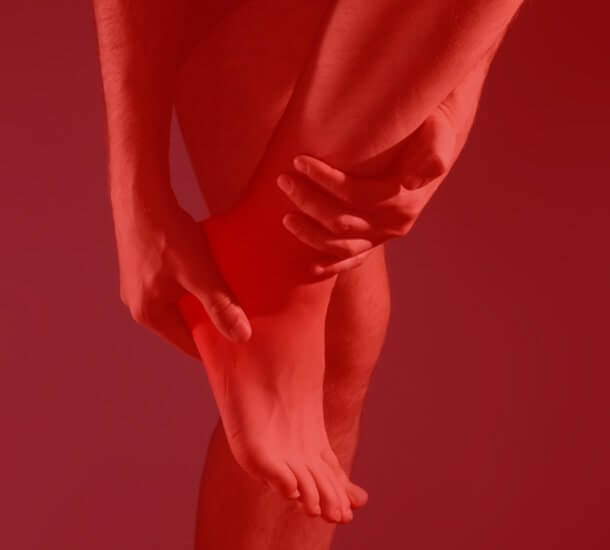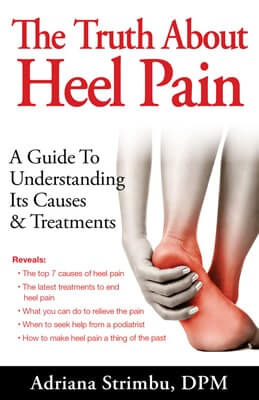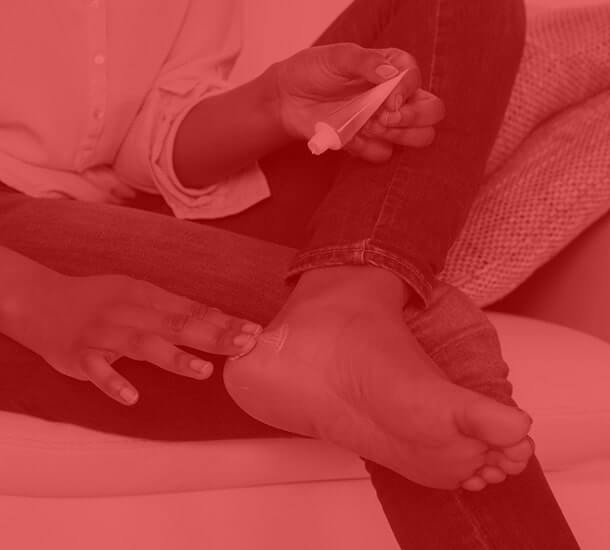
Heel pain (and plantar fasciitis) is one of the most common foot problem our podiatrist here in Hallandale Beach, FL treats. Whether it suddenly started or you have been having heel pain for months, it can be interfering with your life style.
Maybe you are being treated for heel pain or you are looking to get treated. Here at Adriana Strimbu, DPM, PA, we help resolve your heel pain and/or plantar fasciitis pain using the most advanced treatments and by also taking the time to find out the real cause of your heel pain.
We invite you to call our podiatry office in Hallandale Beach, FL to schedule your heel pain / plantar fasciitis consultation today by calling (954) 455-9404 or book an appointment online now.
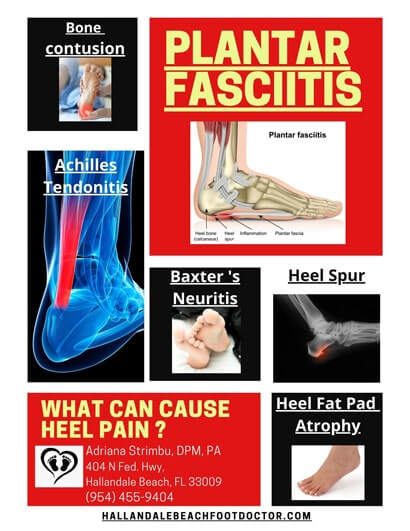
What is heel pain and what causes it?
Heel pain could be due to several different problems. Plantar fasciitis is the most common cause of heel and arch pain.
But other causes of heel pain are heel spurs, Baxter's neuroma, Posterior Tibialis tendonitis, Achilles tendonitis, bone contusion, fat pad atrophy, bursitis, rheumatoid arthritis, excessive pronation, tarsal tunnel syndrome, calcaneal stress fracture, calcaneal apophysitis (in kids).
What is Plantar Fasciitis?
Plantar fasciitis is inflammation to the plantar fascia, a ligament that connects your heel bone to the forefoot.
When the plantar fascia gets tight it starts to get micro-tears thru it and this causes inflammation. It is important to note that the same thing can happen in Achilles tendonitis.
Let's make an analogy. Let's compare the plantar fascia to a rope. So a rope is made of many small threats /strings tight together. The same way, the plantar fascia is made of many small fibers.
Now, for illustration purposes, let's just imagine a rope rolling thru a pulley. Plantar fascia is connected to the Achilles tendon and the calcaneus acts as the pulley. So that plantar fascia which is connected to the Achilles tendon, can be compared to the rope rolling thru a pulley (the pulley being the calcaneus / heel bone).
When this rope is pulled thru the pulley many times, over and over again, the small threads will start to wear out and tear, slowly one by one. The same thing will happen to the plantar fascia and Achilles tendon. Since the plantar fascia and your Achilles tendons are made of this tiny fibers, they will start to wear out when they are tight and overused.
And when this happens, you will get tears in the microfibers within the plantar fascia and/or Achilles tendon. This is how inflammation will form to the area and thus you get pain. And this will be worst, when the plantar fascia and Achilles tendon are also tight.
As mentioned above, there are many other causes of pain in the heel. And making the correct diagnosis could be difficult. Our experienced Hallandale Beach podiatrist will carefully examine and evaluate your heel pain for proper diagnosis and treatment to help your feet get pain free fast.
Here at Adriana Strimbu, DPM, PA, you can get the best treatment for your heel pain at our "Heel Pain Center of Excellence."
Take The Heel Pain Quiz Click Anywhere on The Picture Below:
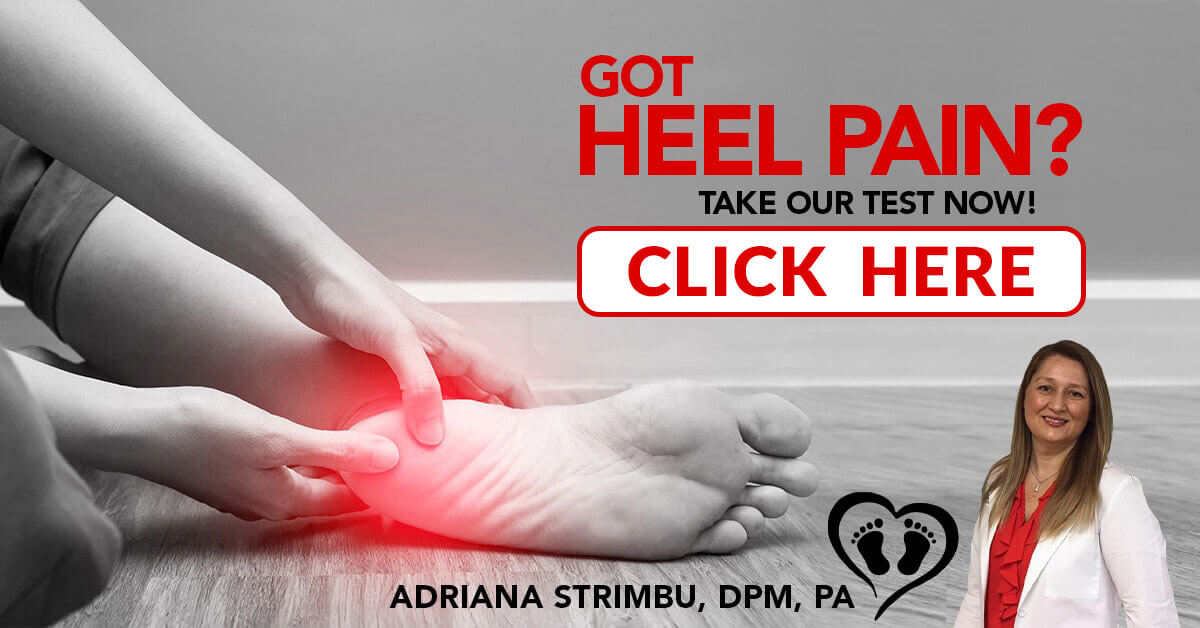
Symptoms of Plantar Fasciitis
The symptoms of plantar fasciitis are:
- Pain in the heel with first step in the morning or after sitting for a period of time and getting up
- Pain is in the bottom of your heel
- Pain could also be worst after exercise or long periods of standing
Causes and Risks of Plantar Fasciitis
Plantar fascia supports the arch of your foot. It runs from the heel bone to your forefoot. When it is tight or stretched too much, it will get microtears causing inflammation. Some of the risk factors for plantar fasciitis are:
- Flat feet (Pes Planus) or High arch (Pes Cavus)
- Obesity
- Wearing high heel shoes
- Wearing non-supportive, thin soled, worned out shoes
- Long standing hours each day
- Tightness of plantar fascia and/or Achilles tendon
- Pregnancy
- Age of 40-60
- Female
- Walking barefooted
Diagnosing Heel Pain and Plantar Fasciitis
Diagnoses of your heel pain is very important as it plays a role into your treatment and what needs to be done to get you better quickly. X-rays are usually done on the first visit in order to rule out fractures, spurs or other bony problems.
Also diagnostic ultrasound could be done to look at the plantar fascia, to rule out rupture of the plantar fascia and see if there is any other soft tissue problems.
MRI is usually used if the pain does not respond to the treatment and it will give us the best picture as to what is happening to your heel. An MRI will give information about the bones as well as the soft tissue and can be of great help.
Best treatments for plantar fasciitis / heel pain
- Stretching Exercises
- Icing
- Avoid walking barefooted
- Custom Orthotics (shoe inserts)
- Laser pain treatment
- Anti-inflammatory medications
- Night splints
- Cortisone (steroid) injections
- Regenerative medicine / injections
- Wearing supportive footwear
- Avoid long-standing hours
Common Questions About Heel Pain / Plantar Fasciitis
What causes heel pain?
He pain can have many different causes but some causes of heel pain are heel spurs, plantar fasciitis, bone contusion, Achilles tendonitis, bursitis, Baxter's neuritis, fat pad atrophy, calcaneal stress fracture, rheumatoid arthritis, excessive pronation, tarsal tunnel syndrome. Most common cause of heel pain, however, is plantar fasciitis. A common cause of pain in the heel for kids is calcaneal apophysitis called Sever's disease.
How common is plantar fasciitis?
Plantar fasciitis is approximately 80% of total cases of heel pain.
Where does plantar fasciitis hurt?
Plantar fasciitis hurts usually in the bottom of your heel area creating a stabbing pain. It is worst with first step in the morning or if you rest for a period of time and when you get up, you will get pain as well.
What does plantar fasciitis pain feel like?
Plantar fasciitis can feel like from an aching pulling pain to the heel and arch of the feet to stabbing pain. It depends on the severity of it. But most plantar fasciitis pain will feel like an aching and pulling pain to your heel and/or arch of the feet.
What is the location of the plantar fasciitis?
Most plantar fasciitis pain is in your heel on the bottom where the plantar fascia connects to the heel bone. However, pain from plantar fasciitis can be long course of the plantar fascia, depending on how tight it is and amount of inflammation present.
Can plantar fasciitis cause ankle pain or leg pain?
Yes. Plantar fasciitis can cause ankle pain and/or leg pain. This happens if inflamed plantar fascia causes irritation or pressure to a nerve branch and it can shut up to the ankle or leg. However, in most cases this problem does not happen.
Does plantar fasciitis hurt all day?
Plantar fasciitis is worst in the morning with the first few steps and then it slowly gets better. Plantar fasciitis can also be worst after long periods of standing and after exercise. Remember, these are the typical patterns. If you get pain to your heel and it lasts the whole day, it could be due to some other cause and it needs to be evaluated. Or it could be that plantar fasciitis becomes chronic.
How can I tell the difference between plantar fasciitis and a heel spur?
You will not be able to tell the difference between plantar fasciitis and a heel spur. You can only see the heel spur when you have an x-ray taken. The symptoms for plantar fasciitis and heel spur are the same.
Is heat or cold better for plantar fasciitis?
Ice is best for the plantar fasciitis and heel pain. It will help decrease the inflammation. Also contrast baths are fine to do.
Can plantar fasciitis go away on its own?
Yes. Plantar fasciitis can go away on its own in many people. However, there are also people that the plantar fasciitis will not go away untreated. It is important to treat plantar fasciitis if it does not resolve to avoid chronic state of plantar fasciitis.
What aggravates the plantar fasciitis?
Plantar fasciitis will get worst if you walk barefooted. Wearing shoes that are non-supportive, and have no arch or thin soles cause cause strain on your plantar fascia and can lead to plantar fasciitis. Being overweight can also make plantar fasciitis worse. Over activity or overuse injury is also a major factor. It can definitely make your plantar fasciitis worst.
Is walking or running bad for plantar fasciitis / heel pain?
Yes. Walking and / or running is bad for plantar fasciitis / heel pain. It is it not recommended that you walk or run with plantar fasciitis or heel pain because it will created overuse and stain to the plantar fascia and it can make it worst.
What causes heel pain when stretching?
What can cause heel pain when stretching is a tight ligaments and tendons. For example, the plantar fascia which is the ligament that supports the arch on the bottom of the foot. It connects the heel bone to the forefoot. When it is tight, and you try to stretch the foot, you will most likely get pain in the heel because the plantar fascia will be pulling on your heel. The same happens with the Achilles tendon. Achilles tendon connects your heel bone to the lower leg. When your Achilles tendon is tight and you stretch, you can get heel pain. Keep in mind that this is one of the reasons why you can get heel pain when stretching. Other reasons could be: torn ligaments and tendons, calcaneal stress fracture, bone contusion, heel spurs, fat pad loss or atrophy, nerve entrapment. It is important to consult with your podiatrist if this pain continues to find out the real cause of your heel pain.
What causes heel pain when waking up?
Most common cause of pain in the heel when waking up with the first step in the morning is plantar fasciitis and/or heel spur.
How to stop plantar fasciitis from coming back?
Most important for plantar fasciitis are stretching exercises and orthotics. That means custom orthotics (shoe inserts) should be warned in your shoes as much as possible. Proper supportive shoe gear is also important. Avoid walking barefooted at any time in order to stop inflammation to your heel. Walking barefooted will put a strain on your plantar fascia and will cause inflammation.
Where can I treat plantar fasciitis and heel pain near me?
Here at Adriana Strimbu, DPM, PA, we treat plantar fasciitis and heel pain. You can call our office at (954) 455-9404 to schedule an appointment for your heel pain or plantar fasciitis pain.
